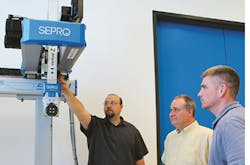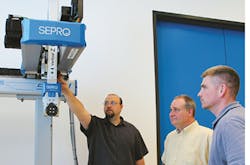Special Report: Manufacturers provide guidance on robot purchasing decisions
An injection molder could have many reasons to consider the purchase of a robot, but determining which model and size are ideal for current and future needs can be difficult.
Any robot manufacturer can provide a sales agent or perhaps an engineer to discuss why a robot would be a benefit in an existing or upcoming project. In this report, two suppliers, Wittmann Battenfeld Inc., Torrington, Conn., and Sepro America LLC, Warrendale, Pa., describe the additional tools they offer to help molders make robot purchasing decisions.
ADVICE FROM SEPRO
"Cost justifications are different with every potential purchaser, but we try to give each of them the information they need. Some want to know what the payback or value-added benefit is if they purchase a new robot, and whether the purchase will improve their molding cycle time or increase their production. Another client may have an existing robot and is looking to upgrade," said Bill Geddis, VP of sales and automation with Sepro America.
Some customers wish to know the mold intervention time — how long the robot spends in between the mold halves. Once the customer provides the size of the press, Sepro can calculate the cost and best robot size.
Sepro created a dynamic spreadsheet that it uses internally for calculating what a robot model can do once the mold opens. The spreadsheet identifies all stroke lengths and operating ranges for each axis of motion — including vertical, horizontal, kick and wrist flip. "We know how long it will take the robot to go down between the mold halves, the time it needs to grip the part and to get out of the press. Sometimes we ask the molder how fast they believe they can eject a part, which is taken into account," said Steve Kendrick, product project manager at Sepro America.
Many times the customer wants to be assured that demolding and parts-handling operations will be consistent and repeatable. "If part handling is a manual operation, a machine operator has to open a safety door, then reach in between the mold platens to grab the part. The operator could be distracted or still completing work on a previously produced part, and that time can be a production variable," Kendrick said.
Worker safety is also a reason to purchase a robot, which can prevent operator injuries that can occur while extracting a part from the mold. Sepro also has several tools that provide the buyer with hands-on experience prior to purchase. Sepro offers three levels of training instruction at its facility or at the molder's plant, with each training level lasting one to three days. The molder learns various aspects of how the automation works and how to program it.
In addition, Sepro's entire sales force carries a simulator, which is a control pendant programmed to function as if it were attached to a Sepro robot, Kendrick said.
The company offers three-axis and five-axis models in two platforms. One is for entry-level or general-purpose applications; the other is higher speed, and offers greater precision to handle more technical tasks. It also offers six-axis robots through agreements with suppliers of these articulated types. Sepro looks at the dimensions and size of the part to ensure there is sufficient clearance to take the part out of the mold without interference, Geddis said.
The company also considers the weight of the end-of-arm-tooling (EOAT) and the part size to determine the torque requirements needed, typically calculated to drive a wrist rotation. Users are also more open to a robot with newer icon-based controllers for ease of use, Geddis said.
WITTMANN BATTENFELD'S BY-THE-BOOK APPROACH
Wittmann Battenfeld offers molders an 18-page booklet entitled "Robots 101" that helps molders determine why they need a robot, how to select one and how to get the most for their money.
The booklet, which was authored by several company employees, lists reasons to employ a robot, including as a means toward eliminating part-quality issues; providing mold protection through part-removal assurance; containing or orienting parts; minimizing part quality issues; and performing post-mold operations. Reasons to replace a robot include improving overall molding speeds, gaining enhanced programming capabilities and utilizing advanced robot features.
Since a new robot can cost $25,000 to $100,000 or more, a molder needs to be able to justify its purchase. Wittmann Battenfeld's booklet features a basic Return on Investment (ROI) calculator in which the molder inputs data regarding part price, cycle time, labor costs, scrap and downtime. The ROI calculator computes new production values that help the molder justify the purchase.
The ROI calculator computes the payback but also provides information on labor reduction, decreased cycle times and scrap, and takes into account robot installation costs and other factors such as lost production due to a damaged mold, said Tom Schaffner, national robot sales manager for Wittmann Battenfeld.
The booklet uses the example of purchasing a robot for use with a machine that is producing parts in two cavities in a 26-second cycle, 40 hours per week for 51 weeks a year, where the part is sold at 5 cents each. The calculator takes the improved cycle time and scrap estimates into account, and predicts the molder would realize a return on the investment of a robot within three months and a savings of up to $735,000 in three years, Schaffner said. The results of the calculation reveal the savings stemming from reduced labor, decreased scrap and increased yield from uniform cycle times.
Details to consider include the stroke of each axis of the robot; payload handling; robot working space; choice of gripper actuation (vacuum or pressure); and inputs and outputs that allow the robot to tie into other pieces of equipment.
Finding a robot that offers user-friendliness is important, Schaffner said. Robot programming and controls should be flexible to handle a range of tasks, and the supplier should offer access to the web or smartphone apps for fast service and support.
Online or offline programming is possible with the company's controllers. Other features that are desirable in the robot control include the ability to integrate various types and brands of injection molding machines into it, and to control downstream automation.
More than one type of support from the supplier is an invaluable tool. Wittmann Battenfeld said it offers flexible training programs that help to reduce human error and downtime while increasing production uptime. It offers maintenance, programming and operation training, as well as customized webinars, videos and tutorials, said Joe Varone, who has been involved in building and installing automation work cells for the company since 1991.
Safety guarding, EOAT and equipment for in-mold and downstream actions, such as degating, part marking, inspection, assembly and packaging, have to be evaluated, said Chris Turnberg, projects manager/senior applications engineer at Wittmann Battenfeld.
Mikell Knights, senior correspondent
Contact:
Sepro America LLC, 412-459-0450, www.sepro-america.com
Wittmann Battenfeld Inc., 860-496-9603, www.wittmann-group.com

